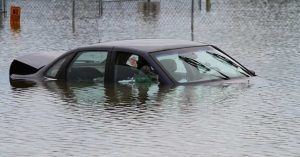
for Audi, BMW, Land Rover, Jaguar, Mercedes,
Mini, Porsche & Volkswagen Repair

for Audi, BMW, Land Rover, Jaguar, Mercedes,
Mini, Porsche & Volkswagen Repair

Having your car subject to the aftermath of heavy storms or floods such as what Houston has experienced recently, is often dangerous and a costly mistake. It is a widespread belief that cars can go through flooded roads and streets, but this is to the detriment of the owner’s wallet as the damage caused by those floodwaters can eat up a large amount of cash and quickly.
Often the damage of a flooded car may not show up immediately. They can present themselves long after the car was submerged in water. Also, keep in mind that salt water is far harsher and more destructive than fresh water. You should always avoid driving through a flooded area.
Here are common car problems that occur because of flooding and suggestions for how to fix, however, a flooded vehicle should be repaired only by an experienced mechanic, not you!
A malfunction in the electronics and electrical system: the parts of a vehicle that sustains the most damage from flooding are usually the electrical and electronics system. A short circuit can be caused because of moisture in the electrical system and this results in the malfunctioning of the car’s critical components. There is also the problem of corrosion which can occur after days or years as the corrosion tends to build up over time. This is the worst issue with owning and driving a flood-damaged car.
To fix issues of electrical system malfunction, make sure to inspect all the electrical systems of the car, also remember that behind panels, in the trunk, under the seats, and under the car hood are buried electrical and electronic components.
When your car gets flooded, you can file for a claim for replacement and repair. Talk to your insurance agent to understand what repairs can be carried out with your insurance plan and then contact our team right away so we can help get you and your car back on the road.